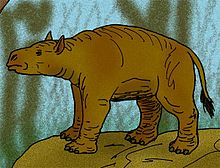Xenungulata
| Xenungulata | |
|---|---|

| |
| Interpretation of Carodnia vieirai | |
| Scientific classification | |
| Kingdom: | Animalia |
| Phylum: | Chordata |
| Class: | Mammalia |
| Clade: | †Meridiungulata |
| Order: | †Xenungulata Paula Couto 1952 |
| Family and genera[3] | |
Xenungulata ("strange ungulates") is an order of extinct and primitive South American hoofed mammals that lived from the Late Paleocene to Early Eocene (Itaboraian to Casamayoran in the SALMA classification). Fossils of the order are known from deposits in Brazil, Argentina, Peru,[4] and Colombia. The best known member of this enigmatic order is the genus Carodnia, a tapir-like and -sized animal with a gait similar to living African elephants.[5]
Description[]
Xenungulates are characterized by M1–2 and M1–2, similar to pyrotheres, and complex lophate third molars, similar to uintatheres. Though other relationships, to arctocyonids for example, have been suggested, no proofs thereof have been found. The foot bones of xenungulates were short and robust and their digits terminated in broad, flat, and unfissured hoof-like unguals, quite unlike any other meridiungulates. The discovery of Etayoa in Colombia[6] made it clear that xenungulates are distinct from other groups: Etayoa lacks lophate molar talonid (in contrast to Carodnia) and, since no distinct lophondonty is present in basal pyrotheres, there is reason to assume that bilophodonty evolved separately in xenungulates and pyrotheres. Xenungulates also show some dental similarity to primitive astrapotheres.[7]
Taxonomy[]
Cifelli 1983 grouped Carodnia with pyrotheres based on a similarity in astragalus morphology, but later concluded that this observation was incorrect.[8]
is most closely related to Etayoa.[9]
Distribution[]

Xenungulata fossils have been found in:[10]
- Bogotá Formation, Casamayoran, Colombia
- , Riochican, Argentina
- , Itaboraian-Riochican, Peru
- Itaboraí Formation, Itaboraian, Brazil
References[]
- ^ Carodniidae in the Paleobiology Database. Retrieved May 2013.
- ^ Gelfo, Javier N.; García-López, Daniel A.; Bergqvist, Lilian P. (2020). "Phylogenetic relationships and palaeobiology of a new xenungulate (Mammalia: Eutheria) from the Palaeogene of Argentina". Journal of Systematic Palaeontology. Online edition (12): 993–1007. doi:10.1080/14772019.2020.1715496. S2CID 213052956.
- ^ "Xenungulata". Palaeocritti. Retrieved 4 May 2013.
- ^ Antoine et al., 2015
- ^ Fariña, Vizcaíno & De Iuliis 2013, p. 86
- ^ Villarroel 1987
- ^ Rose 2006, Xenungulata, p. 238
- ^ Gingerich 1985, p. 131
- ^ Gelfo, López & Bond 2008, Abstract
- ^ Xenungulata at Fossilworks.org
Bibliography[]
- ; ; ; ; ; , and . 2015. A New Carodnia Simpson, 1935 (Mammalia, Xenungulata) from the Early Eocene of Northwestern Peru and a Phylogeny of Xenungulates at Species Level. Journal of Mammalian Evolution 22. 129–140.
- Cifelli, Richard (1983). "Eutherian tarsals from the late Paleocene of Brazil". American Museum Novitates (2761). hdl:2246/5252. OCLC 10601277.Cifelli 1983
- Fariña, Richard A.; Vizcaíno, Sergio F.; De Iuliis, Gerry (2013). Megafauna: Giant Beasts of Pleistocene South America. Indiana University Press. ISBN 9780253007193. OCLC 779244424. Retrieved 4 May 2013.Fariña, Vizcaíno & De Iuliis 2013
- Gelfo, Javier N.; López, Guillermo M.; Bond, Mariano (2008). "A new Xenungulata (Mammalia) from the Paleocene of Patagonia Argentina". Journal of Paleontology. 82 (2): 329–35. doi:10.1666/06-099.1. OCLC 4631927277. S2CID 131263926.Gelfo, López & Bond 2008
- Gingerich, Philip D. (1985). "South American Mammals in the Paleocene of North America" (PDF). In Stehli, Francis G.; Webb, S. David (eds.). The Great American Biotic Interchange. Topics in Geobiology. Vol. 4. Springer. pp. 123–137. doi:10.1007/978-1-4684-9181-4_5. ISBN 978-1-4684-9183-8. OCLC 716806225. Retrieved 4 May 2013.Gingerich 1985
- Rose, Kenneth David (2006). The beginning of the age of mammals. Baltimore: JHU Press. ISBN 978-0801884726.Rose 2006
- Paula Couto, Carlos, de (1952). "Fossil mammals from the beginning of the Cenozoic in Brazil. Condylarthra, Litopterna, Xenungulata, and Astrapotheria". Bulletin of the American Museum of Natural History. 99: 355–394. hdl:2246/417. OCLC 18189741.Paula Couto 1952
- Simpson, George Gaylord (1935). "Descriptions of the oldest known South American mammals, from the Río Chico Formation". American Museum Novitates. Publications of the Scarritt Expeditions, no. 24 (793). hdl:2246/2125. OCLC 44083494.Simpson 1935
- Villarroel, Carlos (1987). "Características y afinidades de Etayoa n. gen., tipo de una nueva familia de Xenungulata (Mammalia) del Paleoceno medio (¿) de Colombia". Comunicaciones Paleontologicas del Museo de Historia Natural del Montevideo. 1 (19): 241–253. OCLC 18731966.Villarroel 1987
- Meridiungulata
- Paleocene mammals of South America
- Eocene mammals of South America
- Paleocene first appearances
- Eocene extinctions
- Casamayoran
- Itaboraian
- Riochican
- Fossil taxa described in 1952